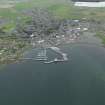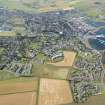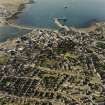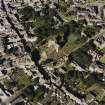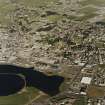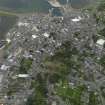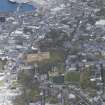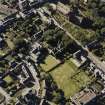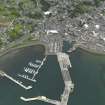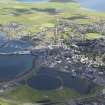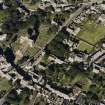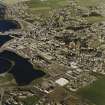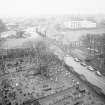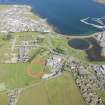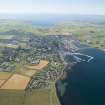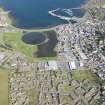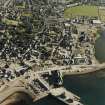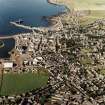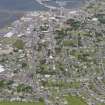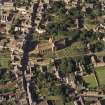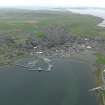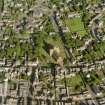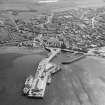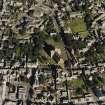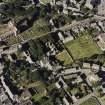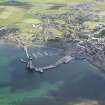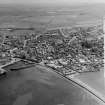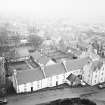Kirkwall, General
Burgh (Medieval) (1486), Town (Medieval)
Site Name Kirkwall, General
Classification Burgh (Medieval) (1486), Town (Medieval)
Canmore ID 2556
Site Number HY41SW 43
NGR HY 44918 10952
NGR Description Centred HY 44918 10952
Datum OSGB36 - NGR
Permalink http://canmore.org.uk/site/2556
- Council Orkney Islands
- Parish Kirkwall And St Ola
- Former Region Orkney Islands Area
- Former District Orkney
- Former County Orkney
HY41SW 43 centred 44918 10952
A charter of 1486, ratified 1536/7, recognised Kirkwall as a city and Royal burgh.
G S Pryde 1965.
Publication Account (1996)
The modern town of Kirkwall has a long and fascinating history of development that is largely masked by its present appearance. The practical orientation of the town today gives the impression of development on either side of a main street running down to the harbour on Kirkwall Bay, though the bleak and largely modern waterfront should give the game away. The clue lies in the Peerie Sea, now a small loch separated from the the bay by a sandspit known as the Aire but once very much bigger and a natural harbour at the head of the bay: the line running approximately northsouth and formed by Albert Street, Broad Street and Victoria Street marks the old shoreline in the medieval period. The process of reclamation of land to the west of that line began very slowly from the 13th century onwards until by 1861 the line of Junction Road marked the contemporary shoreline after 100m of land had been reclaimed (partly by dumping of rubble and earth and partly by natural build-up of shingle). Today the Peerie Sea has shrunk still smaller and its shore lies some 250m from the medieval water-front.
To judge by references in Orkneyinga Saga and artefacts found in recent excavations, there was Viking-age settlement at Kirkwall (ON Kirkjuvagr:church bay) perhaps even before the earliest church was built in the 11th century, but nothing is known of its buildings and it was certainly no urban centre to rival the Norse trading towns of Dublin or York, despite the political importance of the Orkney earldom. Little of the church of St Olaf survives, apart from an attractive carved stone doorway with a round arch, apparently not in its original position but close by, in St Olaf's Wynd off Bridge Street. An 11th-century hogback tombstone was recovered in the early 1970s from the site of St Olaf's churchyard and is now in Tankerness House Museum. The oldest part of Kirkwall, about which least is known, was around and to the north of this church.
Once the building of St Magnus Cathedral was under way from 1137, a second focus of settlement grew up to the south of the first, above the shore of the Peerie Sea. When James III created the royal burgh of Kirkwall in 1486, his charter refers specifically to the two areas of Burgh and Laverock, the former the old town and the latter the diocesan domain around the cathedral. The oldest domestic buildings surviving are parts of the Bishop's Palace (no. 35), begun in the 12th century, and Tankerness House (no. 20), probably of early 16th-century date. Nothing remains of the castle built in the 14th century by the Sinclairs apart from an armorial panel on a later building in Castle Street; it stood on the site of the modern junction between Castle Street, Albert Street and Broad Street, and increasing evidence for the topography of the medieval town suggests that the castle projected out from the shore and was lapped by the sea. It was destroyed in 1615 and its ruins finally demolished in 1865.
Another 16th-century building is the Old GrammarSchool at no. 36 Broad Street, and there is 16th century fabric incorporated into other later buildings, especially in Palace Street and Bishop Reid's house in Vicroria Street (now nos 48, 50 and 52). It is worth exploring the older streets, for there are many interesting architectural legacies to be seen: Broad Street and Victoria Street contain many 17th-century houses and carved stone fragments. The Girnell (no. 22 Harbour Street), along with the adjacent girnell-keeper's house, was built in the early 17th century as the storehouse for the grain paid as rent in kind to the Earl - the grain was stored in wooden chests or girnells. It is a twostorey building with a basement and two external forestairs. Kirkwall's mercat cross was set up in 1621, originally at the west end of the Strynd but it was moved in the 18th century to the green in front of the cathedral (the original cross is now inside the cathedral and a replica stands outside). The most spectacular 17th-century building is the Earl's Palace (no. 32), architecturally at least a fitting neighbour to the cathedral even though the means by which it was built, forced labour, must initially have made it a hated symbol of oppression. Earl Patrick was renowned for a regime of violence and disregard for law, but it was based on a sound economy which allowed him to embark on a princely lifestyle and an appropriately ambitious building programme even though that programme was to lead to personal bankruptcy in the end. He inherited the Bishop's Palace and the Castle, useful in themselves as residence and fortification, but the new palace far outshone the old and his completion of the captured castle in Westray (no. 34) was an essay in the best military architecture of the time.
The wealth accrued by Orcadian landowners from the kelp industry allowed the creation of more town houses in the late 18th century, to which families could withdraw from their rural estates to escape the boredom of the long dark winter. The Laing family of Sanday had Papdale House in Berstane Road, a plain but comfortable threestorey house with a pedimented and slightly projecting centre gable. Sir Waiter Scorr visited this house when he was in Kirkwall in 1814. He was impressed by the Bishop's and Earl's Palaces and by the Cathedral but by little else: 'The town looks well from the sea, but is chiefly indebted to the huge old cathedral that rises out of the centre. Upon landing we find it but a poor and dirty place, especially towards the harbour. Farther up the town are seen some decent old-fashioned houses and the sheriff's interest secures us good lodgings'. To these 'decent old-fashioned houses' were soon added a town house for William Richan of Rapness in Main Street in 1824 (the West End Hotel), Grainbank House in 1829 and Berstane House by David Bryce in 1850.
Adjacent to the Earl's Palace is the Sheriff Court Building, built 1876-7 to a design by the Edinburgh architect David Bryce; by this time Bryce had already successfully completed two major projects in Orkney (Balfour Castle, no. 15, and Trumland House, no. 14), and his confidence was such that initially he had proposed restoring the Earl's Palace itself. The Police Commissioners preferred to build a new - for which we should perhaps be thankful - and the present, fairly austere Sheriff Court Building stands alongside and in pleasant contrast to the earlier ornate residence of the earls of Orkney.
There are carved stones of 16th-century date reused in the east and west gables, two with the arms of Bishop Robert Reid and one with those of Bishop Edward Stewart.
Notable among other 19th-century buildings are the group of artisans' dwellings built early that century at no. 22 St Catherine's Place (two-storeyed with crowstepped gables) and the Town Hall, built by the Kirkwall architect, T S Peace, between 1884-7 at the corner of Broad Street and St Magnus Lane, with a pilastered entrance in Scots Renaissance style surmounted by the burgh coat-of-arms and statues. Peace also added the tower in 1886 to the episcopal church of St Olaf, designed and built by Alexander Ross in 1875-6 in Dundas Crescent. This interesting church also holds relics of older churches, including an octagonal font from St Mary's in Rousay, aumbreys from the 16th-century St Olaf's Church in Kirkwall and a wooden chancel screen created out of the remains of an early 17th-century episcopal gallery and throne from St Magnus Cathedral. In Albert Street is the charming Custom House, a narrow building with a pilastered main door, which was built in the early 19th century for Captain Balfour of Trenabie in Westray.
There were no substantial harbour facilities until the early 19th century, when two piers forming a sheltered basin were constructed. One of the new industries in Kirkwall to have left tangible evidence is whisky distilling, for the Highland Park Distillery in Holm Road was established in 1798 and flourishes today; most of its distinctive buildings belong to the 19th century with later additions, such as the tow of bonded warehouses and the pagoda-roofed kilns.
Information from ‘Exploring Scotland’s Heritage: Orkney’, (1996).

























































































